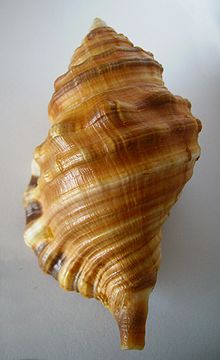- Monoplex parthenopeus
-
Monoplex parthenopeus A shell of Monoplex parthenopeus with periostracum removed Conservation status Scientific classification Kingdom: Animalia Phylum: Mollusca Class: Gastropoda (unranked): clade Caenogastropoda
clade Hypsogastropoda
clade LittorinimorphaSuperfamily: Tonnoidea Family: Ranellidae Subfamily: Cymatiinae Genus: Monoplex Species: M. parthenopeus Binomial name Monoplex parthenopeus
(Salis-Marschlins, 1793)Synonyms[2] - Cymatium (Monoplex) echo Kuroda & Habe in Kira, 1961
- Cymatium (Monoplex) echo iwakawanum sensu Kuroda & Kira Shikama, 1964
- Cymatium (Monoplex) parthenopeum (Salis, 1793)
- Cymatium echo Kuroda & Habe in Kira, 1961
- Cymatium parthenopeum (Von Salis, 1793)
- Dissentoma prima Pilsbry, 1945
- Monoplex australasiae Perry, 1811
- Murex costatus Born, 1778
- Murex costulatus Risso, 1826
- Murex parthenopus Salis-Marschlins, 1793
- Triton (Simpulum) acclivis Hutton, 1873
- Triton americanum d’Orbigny, 1842
- Triton brasilianum Gould, 1849
- Triton fossatum Gould, 1860
- Triton succinctum Lamarck, 1816
Monoplex parthenopeus,[3][4] common name the hairy trumpet,[citation needed] also known as Monoplex parthenopeus,[2] is a species of predatory sea snail, a marine gastropod mollusk in the family Ranellidae, the triton snails, triton shells or tritons.[2]
Contents
Distribution
This species occurs worldwide including:
- The Western Atlantic Ocean[4]
- New Zealand[5]
Description
The maximum recorded shell length is 180 mm.[6]
Habitat
Minimum recorded depth is 0 m.[6] Maximum recorded depth is 75 m.[6]
Life cycle
Hairy trumpets are notable for having particularly long planktonic periods. The veliger larvae remain in the plankton for nearly 300 days, dispersing as far as 4000 km.[7] This is the longest known larval duration and dispersal distance of any marine invertebrate which occurs along the west coast of North America.[8]
References
- ^ Mollusc Specialist Group (2000). Cymatium parthenopaeum. 2006 IUCN Red List of Threatened Species. Downloaded on 6 August 2007.
- ^ a b c Monoplex parthenopeus (Salis-Marschlins, 1793). WoRMS (2010). Monoplex parthenopeus (Salis-Marschlins, 1793). In: Bouchet, P.; Gofas, S.; Rosenberg, G. (2010) World Marine Mollusca database. Accessed through: World Register of Marine Species at http://www.marinespecies.org/aphia.php?p=taxdetails&id=476531 on 8 May 2011.
- ^ "Cymatium parthenopeum (Salis, 1793)", CLEMAM, accessed 18 February 2011.
- ^ a b "Cymatium parthenopeum (von Salis, 1793)". Malacolog Version 4.1.1. A Database of Western Atlantic Marine Mollusca. accessed 17 February 2011.
- ^ Powell A. W. B., New Zealand Mollusca, William Collins Publishers Ltd, Auckland, New Zealand 1979 ISBN 0-00-216906-1
- ^ a b c Welch J. J. (2010). "The “Island Rule” and Deep-Sea Gastropods: Re-Examining the Evidence". PLoS ONE 5(1): e8776. doi:10.1371/journal.pone.0008776.
- ^ Scheltema, R. S. 1971. Larval dispersal as a means of genetic exchange between geographically separated populations of shoalwater benthic marine gastropods. Biological Bulletin 140:284–322.
- ^ AL Shanks, BA Grantham, MH Carr (2003) Propagule dispersal distance and the size and spacing of marine reserves. Ecological Applications, 13, S159-S169.
- Gofas, S.; Afonso, J.P.; Brandào, M. (Ed.). (S.a.). Conchas e Moluscos de Angola = Coquillages et Mollusques d'Angola. [Shells and molluscs of Angola]. Universidade Agostinho / Elf Aquitaine Angola: Angola. 140 pp
- Gofas, S.; Le Renard, J.; Bouchet, P. (2001). Mollusca, in: Costello, M.J. et al. (Ed.) (2001). European register of marine species: a check-list of the marine species in Europe and a bibliography of guides to their identification. Collection Patrimoines Naturels, 50: pp. 180-213
- Rolán E., 2005. Malacological Fauna From The Cape Verde Archipelago. Part 1, Polyplacophora and Gastropoda.
- Rosenberg, G., F. Moretzsohn, and E. F. García. 2009. Gastropoda (Mollusca) of the Gulf of Mexico, Pp. 579–699 in Felder, D.L. and D.K. Camp (eds.), Gulf of Mexico–Origins, Waters, and Biota. Biodiversity. Texas A&M Press, College Station, Texas
External links
Categories:- IUCN Red List least concern species
- Ranellidae
Wikimedia Foundation. 2010.



